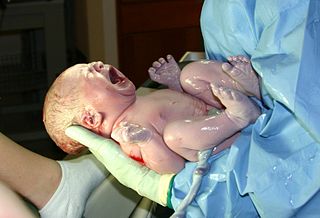
A loom is a device used to weave cloth and tapestry. The basic purpose of any loom is to hold the warp threads under tension to facilitate the interweaving of the weft threads. The precise shape of the loom and its mechanics may vary, but the basic function is the same.

An infant is a formal or specialised synonym for the common term baby, meaning the very young offspring of human beings. The term may also be used to refer to juveniles of other organisms. A newborn is, in colloquial use, an infant who is only hours, days, or up to one month old. In medical contexts, newborn or neonate refers to an infant in the first 28 days after birth; the term applies to premature, full term, and postmature infants.

A lullaby, or cradle song, is a soothing song or piece of music that is usually played for children. The purposes of lullabies vary. In some societies they are used to pass down cultural knowledge or tradition. In addition, lullabies are often used for the developing of communication skills, indication of emotional intent, maintenance of infants' undivided attention, modulation of infants' arousal, and regulation of behavior. Perhaps one of the most important uses of lullabies is as a sleep aid for infants. As a result, the music is often simple and repetitive. Lullabies can be found in many countries, and have existed since ancient times.
Motion JPEG is a video compression format in which each video frame or interlaced field of a digital video sequence is compressed separately as a JPEG image.

A hammock is a sling made of fabric, rope, or netting, suspended between two or more points, used for swinging, sleeping, or resting. It normally consists of one or more cloth panels, or a woven network of twine or thin rope stretched with ropes between two firm anchor points such as trees or posts. Hammocks were developed by native inhabitants of the Americas for sleeping, as well as the English. Later, they were used aboard ships by sailors to enable comfort and maximize available space, and by explorers or soldiers travelling in wooded regions. Eventually, in the 1920s, parents throughout North America used fabric hammocks to contain babies just learning to crawl. Today they are popular around the world for relaxation; they are also used as a lightweight bed on camping trips. The hammock is often seen as a symbol of summer, leisure, relaxation and simple, easy living.
An accelerometer is a tool that measures proper acceleration. Proper acceleration is the acceleration of a body in its own instantaneous rest frame; this is different from coordinate acceleration, which is acceleration in a fixed coordinate system. For example, an accelerometer at rest on the surface of the Earth will measure an acceleration due to Earth's gravity, straight upwards of g ≈ 9.81 m/s2. By contrast, accelerometers in free fall will measure zero.
A waterbed, water mattress, or flotation mattress is a bed or mattress filled with water. Waterbeds intended for medical therapies appear in various reports through the 19th century. The modern version, invented in San Francisco and patented in 1971, became a popular consumer item in the United States through the 1980s with up to 20% of the market in 1986 and 22% in 1987. By 2013, they accounted for less than 5% of new bed sales.

A swing is a seat, often found at playgrounds for children, at a circus for acrobats, or on a porch for relaxing, although they may also be items of indoor furniture, such as the Latin American hammock or the Indian oonjal. The seat of a swing may be suspended from chains or ropes. Once a swing is in motion, it continues to oscillate like a pendulum until external interference or drag brings it to a halt. Swing sets are very popular with children.

A pillow is a support of the body at rest for comfort, therapy, or decoration. Pillows are used by many species, including humans. Some types of pillows include throw pillows, body pillows, decorative pillows and many more. Pillows that aid sleeping are a form of bedding that supports the head and neck. Other types of pillows are designed to support the body when lying down or sitting. There are also pillows that consider human body shape for increased comfort during sleep. Decorative pillows used on people, couches or chairs are sometimes referred to as cushions.

A baby shower is a party of gift-giving or a ceremony that has different names in different cultures. It celebrates the delivery or expected birth of a child or the transformation of a woman into a mother.

A bed is an item of furniture that is used as a place to sleep, rest, and relax.

An infant bed is a small bed especially for infants and very young children. Infant beds are a historically recent development intended to contain a child capable of standing. The cage-like design of infant beds restricts the child to the bed. Between one and two years of age, children are able to climb out and are moved to a toddler bed to prevent an injurious fall while escaping the bed.

A sex swing is a type of harness designed to allow sexual intercourse between one partner suspended by the swing and another who moves freely. Though there is considerable variety in the design, the most common sex swings have a support for the back, another for the buttocks, and stirrups for each leg, which can be adjusted whilst the user is suspended.

A bassinet, bassinette, or cradle is a bed specifically for babies from birth to about four months. Bassinets are generally designed to work with fixed legs or castors, while cradles are generally designed to provide a rocking or gliding motion. Bassinets and cradles are distinguished from Moses baskets and carry cots, which are designed to be carried and sit directly on the floor or furniture. After four months, babies are often transferred to a crib or cot. In the United States, however, the bedside sleeper is the prevalent option, since they are generally bigger, recommended up to 6 months, and often used up to a year.

A portaledge is a deployable hanging tent system designed for rock climbers who spend multiple days and nights on a big wall climb. An assembled portaledge is a fabric-covered platform surrounded by a metal frame that hangs from a single point and has adjustable suspension straps. A separate cover, called a stormfly, covers the entire system in the event of bad weather.
A sensation of falling occurs when the labyrinth or vestibular apparatus, a system of fluid-filled passages in the inner ear, detects changes in acceleration. This sensation can occur when a person begins to fall, which in terms of mechanics amounts to a sudden acceleration increase from zero to roughly 9.81 m/s2. If the body is in free fall with no other momenta there is no falling sensation. This almost never occurs in real-life falling situations because when the faller leaves their support they are usually very significant quantities of residual momenta such as rotation and these momenta continue as the person falls, causing a sensation of dysphoria. The faller doesn't fall straight down but spins, flips, etc. due to these residual momenta and also due to the asymmetric forces of air resistance on their asymmetric body. While velocity continues to increase, the downward acceleration due to gravity remains constant. Increasing drag force may even cause a feeling of ascent.

Harvey Neil Karp, FAAP is an American pediatrician. He is an Assistant Professor of Pediatrics at the Keck School of Medicine at the University of Southern California and a fellow of the American Academy of Pediatrics. Karp lives in Los Angeles with his wife Nina Montée Karp.
Infant sleep training refers to a number of different regimens parents employ to adjust their child's sleep behaviors.
A baby jumper is a device that can be used by infants to exercise and play in. The original baby jumper consists of a hoop suspended by an elastic strap. More elaborate baby jumpers have a base made of hard plastic sitting in a frame and a suspended fabric seat with two leg holes, often with trays holding toys. The door jumpers lack the tray. There are also mobile play centers, which look very similar to baby jumpers, but which have wheels.













